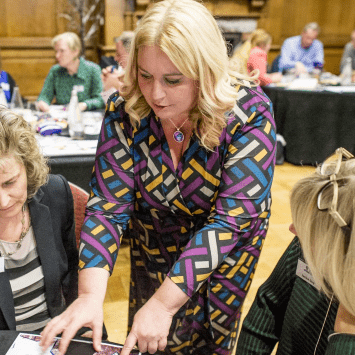Posted in Blog, Design Thinking, Facilitation, Virtual Facilitation by Jo North
Reverse Brainstorming
Reverse brainstorming is a targeted approach to scrutinizing and refining existing ideas by generating critiques. Most useful for evaluating a shortlist rather than during the initial sifting of ideas, the reverse brainstorming method works brilliantly in scenarios where new or complex ideas have little room for error, where sequences of events must align perfectly, or when implementation spans various teams.
Reverse brainstorming is sometimes known as ‘negative brainstorming’. The essence of the reverse brainstorming method is simple. It uses the usual brainstorming approach to pinpoint what could go wrong in a project, helping to spot possible issues before they happen. As a result, reverse brainstorming can initially seem starkly pessimistic—it’s sometimes even termed the “tear-down” method. But, when it’s facilitated well, it actually feels positive and energizing.
Here’s how to leverage reverse brainstorming in your creative problem solving workshops, innovation sprints and design thinking, and why it could be your go-to for sparking new ideas.
How Reverse Brainstorming Works
The reverse brainstorming process begins with the team members focusing on negative outcomes related to the specific problem at hand. By highlighting possible negative ideas, the group can uncover potential problems and root causes that might not emerge in traditional brainstorming sessions.
The Method in Action
1. Problem identification
Start by clearly stating the original problem or challenge. This ensures that all team members understand the issue at hand.
2. Generate negative outcomes
Use a flipchart or online whiteboards to collect ideas about what could go wrong. This step opens up new perspectives and uncovers potential issues.
3. Transforming negative to positive
Next, flip each negative idea to find creative solutions. This is where negative thoughts become potential solutions.
Reverse Brainstorming: Quick Example
Consider customer service. Using reverse brainstorming, teams can identify possible reverse solutions to improve customer satisfaction. By working through negative questions in real time, the team can address potential risks and come up with effective solutions.
Why Use Reverse Brainstorming?
Reverse brainstorming flips traditional methods, encouraging a fresh approach to problem-solving. It can have the opposite effect of typical brainstorming by providing:
- A fresh perspective. It prompts the team to look at the problem from unconventional angles.
- Effective solutions. By focusing on negative aspects, it often reveals the best way to prevent or solve potential problems.
- Permission to raise concerns. Reverse brainstorming provides an opportunity for the team to share their concerns without judgement.
Steps to Successful Reverse Brainstorming
A successful session follows these steps:
- First step: Define the problem and set a time limit for the session to ensure focus.
- Second step: Collect negative ideas, allowing for wild ideas and absurd suggestions.
- Third step: Turn the ‘bad ideas’ into creative solutions, looking for the best ideas that offer real solutions.
Reverse brainstorming is a great creative problem-solving technique that can lead to innovative solutions. It’s a really useful tool to add to your facilitation toolkit.
Next Steps
For tips, techniques and guidance on how to facilitate a brainstorming session, take a look at these guides:
- How to facilitate a virtual brainstorming session
- Ideas for planning your team away day
- Creative questions to power your innovation workshops
- How to get ideas flowing in online meetings
- You and your ideas: learn how to be more creative
If you’d like to explore more creativity techniques for your workshops, team meetings and design sprints, you’ll find these other articles helpful:


